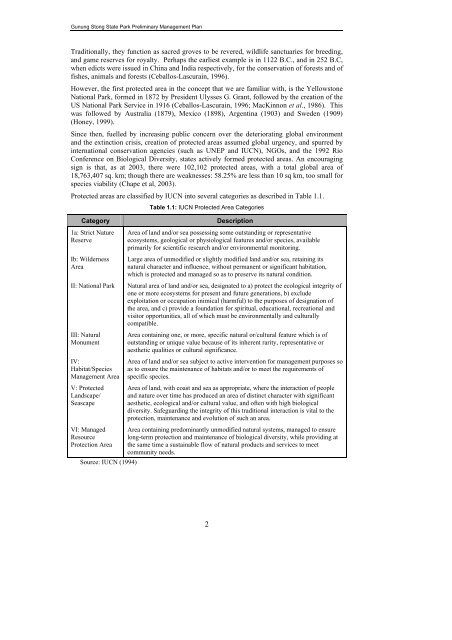FINAL VERSION FOR APPROVAL - Sdn Bhd - WWF Malaysia
FINAL VERSION FOR APPROVAL - Sdn Bhd - WWF Malaysia
FINAL VERSION FOR APPROVAL - Sdn Bhd - WWF Malaysia
You also want an ePaper? Increase the reach of your titles
YUMPU automatically turns print PDFs into web optimized ePapers that Google loves.
Gunung Stong State Park Preliminary Management Plan<br />
Traditionally, they function as sacred groves to be revered, wildlife sanctuaries for breeding,<br />
and game reserves for royalty. Perhaps the earliest example is in 1122 B.C., and in 252 B.C,<br />
when edicts were issued in China and India respectively, for the conservation of forests and of<br />
fishes, animals and forests (Ceballos-Lascurain, 1996).<br />
However, the first protected area in the concept that we are familiar with, is the Yellowstone<br />
National Park, formed in 1872 by President Ulysses G. Grant, followed by the creation of the<br />
US National Park Service in 1916 (Ceballos-Lascurain, 1996; MacKinnon et al., 1986). This<br />
was followed by Australia (1879), Mexico (1898), Argentina (1903) and Sweden (1909)<br />
(Honey, 1999).<br />
Since then, fuelled by increasing public concern over the deteriorating global environment<br />
and the extinction crisis, creation of protected areas assumed global urgency, and spurred by<br />
international conservation agencies (such as UNEP and IUCN), NGOs, and the 1992 Rio<br />
Conference on Biological Diversity, states actively formed protected areas. An encouraging<br />
sign is that, as at 2003, there were 102,102 protected areas, with a total global area of<br />
18,763,407 sq. km; though there are weaknesses: 58.25% are less than 10 sq km, too small for<br />
species viability (Chape et al, 2003).<br />
Protected areas are classified by IUCN into several categories as described in Table 1.1.<br />
Table 1.1: IUCN Protected Area Categories<br />
Category<br />
1a: Strict Nature<br />
Reserve<br />
Ib: Wilderness<br />
Area<br />
II: National Park<br />
III: Natural<br />
Monument<br />
IV:<br />
Habitat/Species<br />
Management Area<br />
V: Protected<br />
Landscape/<br />
Seascape<br />
VI: Managed<br />
Resource<br />
Protection Area<br />
Source: IUCN (1994)<br />
Description<br />
Area of land and/or sea possessing some outstanding or representative<br />
ecosystems, geological or physiological features and/or species, available<br />
primarily for scientific research and/or environmental monitoring.<br />
Large area of unmodified or slightly modified land and/or sea, retaining its<br />
natural character and influence, without permanent or significant habitation,<br />
which is protected and managed so as to preserve its natural condition.<br />
Natural area of land and/or sea, designated to a) protect the ecological integrity of<br />
one or more ecosystems for present and future generations, b) exclude<br />
exploitation or occupation inimical (harmful) to the purposes of designation of<br />
the area, and c) provide a foundation for spiritual, educational, recreational and<br />
visitor opportunities, all of which must be environmentally and culturally<br />
compatible.<br />
Area containing one, or more, specific natural or/cultural feature which is of<br />
outstanding or unique value because of its inherent rarity, representative or<br />
aesthetic qualities or cultural significance.<br />
Area of land and/or sea subject to active intervention for management purposes so<br />
as to ensure the maintenance of habitats and/or to meet the requirements of<br />
specific species.<br />
Area of land, with coast and sea as appropriate, where the interaction of people<br />
and nature over time has produced an area of distinct character with significant<br />
aesthetic, ecological and/or cultural value, and often with high biological<br />
diversity. Safeguarding the integrity of this traditional interaction is vital to the<br />
protection, maintenance and evolution of such an area.<br />
Area containing predominantly unmodified natural systems, managed to ensure<br />
long-term protection and maintenance of biological diversity, while providing at<br />
the same time a sustainable flow of natural products and services to meet<br />
community needs.<br />
2
















